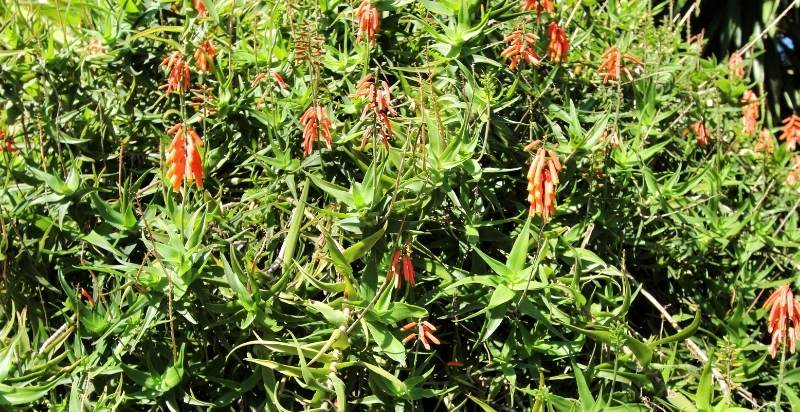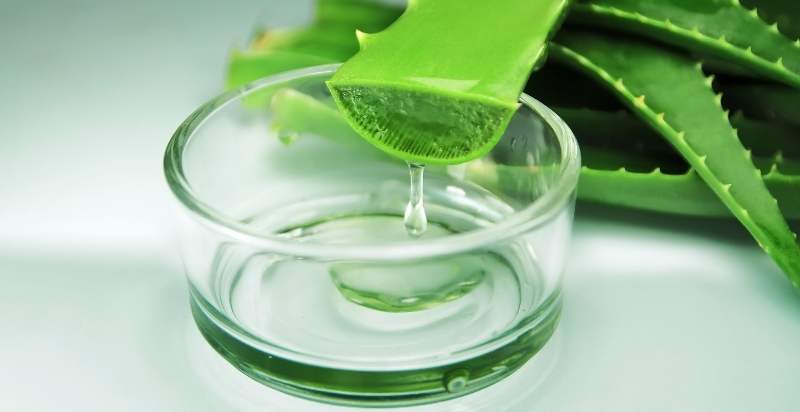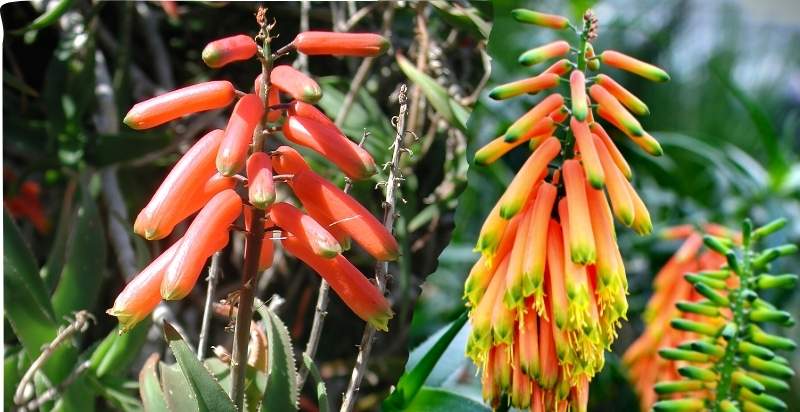The world of aloes is incredibly diverse, with over 500 species. These plants come in various shapes, sizes, and colors, making them popular for indoor and outdoor gardens. One of the more unusual members of the aloe family is Aloe ciliaris, also known as the climbing aloe. This plant is native to South Africa and gets its name from its long, trailing stems that can reach up to 6 feet in length.
If you’re thinking about adding a climbing aloe to your home, read on for everything you need to know about this unique plant!
Aloe Ciliaris: Were Does It Come From?
Aloe ciliaris, also known as African Aloe, is a flowering plant in the genus Aloe that is native to Africa. The plant is stemless or has very short stems and grows up to 1.5 m tall. The leaves are green with white spots and have spiny margins. The flowers are yellow and borne in inflorescences at the apex of the leaf rosette.
It is found in Ethiopia, Kenya, Somalia, Tanzania, and Uganda. It occurs in dry bushland and rocky areas at 1000-2000 m.
The plant is used medicinally in East Africa to treat wounds and burns. The sap from the leaves is applied to the skin or taken orally for these purposes. It is also used as a purgative and an emetic.

Benefits of Aloe Ciliaris:
Aloe ciliaris is used as an ornamental plant in home and garden settings. The plant is tolerant of drought and can thrive in poor-quality soil. It is also used in xeriscaping or the landscaping of dry areas.
The leaves of aloe ciliaris contain latex, a compound with laxative effects. Cape aloe latex is often taken orally to treat constipation. Latex can also be applied to the skin to relieve inflammation and promote the healing of wounds.
It gel can also be applied to the skin to relieve inflammation and promote the healing of wounds. It gel is thought to have antimicrobial properties, which may help prevent wound infection.
In recent years, aloe ciliaris has been gaining popularity as an ingredient in skin care products. This is due to its purported benefits for the skin, such as reducing inflammation and boosting collagen production. If you’re interested in trying aloe ciliaris for your skin, you can find it in various skin care products, including serums, creams, and masks. You can also purchase the plant itself and extract the gel from the leaves to use topically.
When used appropriately, aloe ciliaris is safe for most people. However, it’s always best to do a patch test on a small skin area before using any new product, especially if you have sensitive skin.

How To Plant Aloe Ciliaris In Your Home And Garden?
Aloe ciliaris is easy to care for and doesn’t require much water, so it’s perfect for those new to growing succulents. Here’s everything you need to know about how to plant and care for aloe ciliaris.
- When selecting a pot for your it, choose one that has good drainage holes in the bottom. You can use either clay or plastic pot, but make sure it’s big enough to accommodate the plant’s roots. It doesn’t need much growing space, so a small pot is fine.
- Fill your pot with a well-draining succulent or cactus potting mix. If you can’t find this mix, you can make your own by mixing equal parts sand, perlite, and peat moss.
- To plant your aloe ciliaris, gently remove it from its current pot and loosen the roots. Place the plant in the center of the new pot and backfill it with the potting mix. Water thoroughly, but be sure not to overwater – succulents are prone to root rot if kept too wet.
- Once your aloe ciliaris is planted, give it a few days to adjust to its new home before fertilizing. Use a succulent fertilizer or a cactus fertilizer diluted to half-strength. Apply the fertilizer every other week during the growing season (spring and summer).
- When watering your aloe ciliaris, always check the soil first to ensure it’s dry. These plants are very drought tolerant and only need to be watered once every one to two weeks. If you live in an area with low humidity, you may need to water your plant more often. Allow the soil to dry out completely between waterings.
- Bring your aloe ciliaris indoors for the winter months if you live in a cold climate. These plants are not frost-tolerant and will not survive if the temperature dips below 50 degrees Fahrenheit.
With proper care, your aloe ciliaris will thrive for many years. These beautiful plants make a great addition to any indoor or outdoor space and are sure to add a touch of style to your home.
Where Can You Buy These Plants?
Aloe ciliaris plants are available for purchase from many online retailers, and you can also find them at some nurseries and garden centers. When purchasing an aloe ciliaris plant, look for one that’s healthy and has robust leaves. Avoid plants that are wilted or have brown or yellow leaves, as these may be indications of poor health.
Prices for aloe ciliaris plants vary depending on the size and condition of the plant. Smaller plants typically cost between $10 and $20, while larger, healthier plants can cost up to $50.
How to Propagate New Plants From Cuttings Taken From A Mature Aloe Ciliaris Specimen:
If you want to propagate a new plant from a mature Aloe ciliaris specimen, you can do so by taking cuttings from the plant. To take a cutting, use a sharp knife or garden shears to cut a piece of the plant at least 3-4 inches long. Ensure the cutting has at least two leaves, and avoid getting flower buds or flowers on the cutting.
Once you have your cutting, please place it in a pot or container filled with well-draining potting mix. Water the soil lightly, then place the pot in a bright, sunny location. Keep the soil moist but not wet; in 4-6 weeks, you should see new roots forming. Once the roots are well-established, you can transplant your new plant into a larger pot or garden.

How to Care For The New Plants:
Aloe ciliaris is a succulent plant, so it does not need a lot of water. Water the plant when the soil is dry to the touch, and then allow the soil to dry out completely before watering again. During the winter months, you can reduce watering even further. If you live in an area that gets frost or snow in the winter, it is best to bring your plants indoors.
It grows best in full sun to partial shade. If you live in a hot, sunny climate, it is best to provide some afternoon shade for your plants. It can tolerate some light frost in colder climates but will not survive if the temperature drops too low.
Fertilize your aloe ciliaris plants every few months with succulent plant fertilizer. Follow the instructions on the package for the best results.
Aloe ciliaris is a relatively low-maintenance plant, but it can be susceptible to mealybugs and other pests. Inspect your plants regularly and remove any pests you find. If you notice any yellowing or browning of the leaves, this could signify overwatering or poor drainage. Be sure to check the soil before watering your plants, and water only when the soil is dry to the touch.
Creative Ways To Use Aloe Ciliaris In Your Garden?
Aloe ciliaris can be used in many ways in the home and garden. Here are some ideas:
- Use the leaves as a natural pesticide.
- Place the leaves in a sunny spot in your home to help purify the air.
- Make a natural insect repellent by combining its juice with water and spraying it around your home.
- Add Aloe Ciliaris to your compost pile to help speed up the decomposition process.
- Use the leaves as mulch around your plants to help retain moisture and deter weeds.
- Make a natural skin care product by combining Aloe Ciliaris juice with other ingredients like honey or avocado oil.
- Use the leaves to make a natural dye for fabric or yarn.
- Extract the juice from the leaves and use it as a natural cleaning solution around your home.
- Make a natural fire starter by soaking its leaves in rubbing alcohol.
- The gel inside the leaves can treat burns, scrapes, and other skin ailments.
Any Risks Associated With Using Aloe Ciliaris Plants In Your Garden?
Aloe ciliaris plants are generally considered safe to use around the home or garden. However, as with any plant, some potential risks are associated with using it The most common risk is that the plant can cause skin irritation if it comes into contact with the skin.
If you have sensitive skin, it is best to avoid coming into contact with the plant. In addition, the plant can also cause gastrointestinal upset if ingested. Therefore, keeping the plant out of reach of children and pets is important.
If you have any concerns about using Aloe Ciliaris plants in your home or garden, please consult with a healthcare professional before doing so.
Conclusion
Aloe ciliaris is a versatile plant that can be used in many different ways. Whether you want to use it for its medicinal properties or as a natural dye or cleaning solution, this plant is a great addition to any home or garden. With just a little care, your aloe ciliaris plants will thrive and provide you with years of enjoyment.
- Everything You Wanted to Know About Red Tamarillos - June 2, 2025
- A Guide to Tulips: Everything You Need to Know & More… - June 2, 2025
- Guanabana: Description, Flavor, Benefits, And Uses - May 27, 2025
